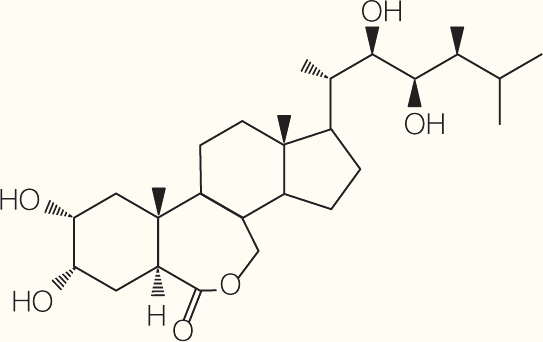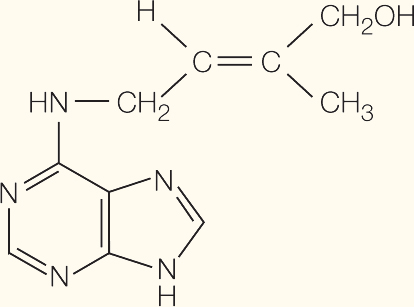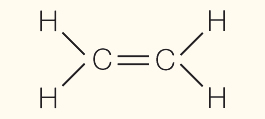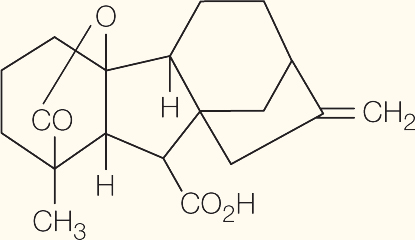Several hormones and photoreceptors help regulate plant growth
The above description of the early stages of plant development illustrates some of the environmental cues that influence plant growth. A plant’s responses to these cues involve signal transduction pathways. Various mechanisms are used by the plant to sense changes in the environment, and these mechanisms activate signal transduction pathways that result in the synthesis and activation of specific plant hormones. In turn, these hormones act as signals that trigger pathways resulting in changes in plant growth. In most cases these changes involve alterations in the expression of specific genes.
Hormones are chemical signals that act at very low concentrations at target sites often distant from where they are produced. Most plant hormones are very different from their counterparts in animals (Table 36.1). Each plant hormone plays multiple regulatory roles, and interactions among them can be complex. Several hormones regulate the growth and development of plants from seedling to adult (Table 36.2). Other hormones (for example, jasmonic acid and salicylic acid) are involved in the plant’s defenses against herbivores and microorganisms, as we will discuss in Chapter 38.
| Characteristic | Plant hormones | Animal hormones |
|---|---|---|
| Size, chemistry | Peptides, small organic molecules | Peptides, proteins, small molecules |
| Site of synthesis | Usually at many locations | Specialized glands or cells |
| Site of action | Local or distant | Usually distant, transported |
| Effects | Often diverse | Often specific |
| Regulation | By biochemical feedback | By central nervous system, ions, or feedback |
| Hormone | Structure | Typical activities |
|---|---|---|
| Abscisic acid* |

|
Maintains seed dormancy; closes stomata |
| Auxins (mainly indole- |

|
Promote stem elongation, adventitious root initiation, and fruit growth; inhibit axillary bud outgrowth, leaf abscission, and root elongation |
| Brassinosteroids |

|
Promote stem and pollen tube elongation; promote vascular tissue differentiation |
| Cytokinins |

|
Inhibit leaf senescence; promote cell division and axillary bud outgrowth; affect root growth |
| Ethylene |

|
Promotes fruit ripening, leaf abscission, and senescence; inhibits stem elongation and gravitropism |
| Gibberellins (e.g., gibberellic acid) |

|
Promote seed germination, stem growth, and ovule and fruit development; break winter dormancy; mobilize nutrient reserves in grass seeds |
|
*See Chapter 37. |
||
Perhaps the most important environmental cue for a plant is light: the source of energy for photosynthesis. Plants have an abundance of photoreceptors that detect changes in the quality and direction of light as well as the timing of light availability (day length). Photoreceptors are often proteins associated with pigments. Light acts directly on photoreceptors, which in turn regulate developmental processes that need to be responsive to light, such as the many changes that occur as a seedling emerges from the soil.